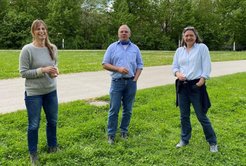Water connects above and below ground habitats

AquaDiva speakers Kirsten Küsel, Kai Uwe Totsche and Susan Trumbore are celebrating the good news (copyright Anke Hädrich, FSU Jena)
The German Research Foundation (DFG) has extended funding for three Collaborative Research Centers (SFB) at Friedrich Schiller University Jena. Among them is the SFB AquaDiva, which will receive around eleven million euros for the next four years in its third funding period.
The "critical zone" is the porous skin of the Earth where air, water, rock and organisms interact. It extends from vegetation through soil and rock down to groundwater, in some cases several hundreds of meters deep, and is connected by fluid flow and mass transfer. Humans depend on its resources - from water supply to food production. Pollution, land use and climate change are increasingly altering above-ground habitats - but what impact this has on below-ground habitats often remains hidden.
That is why scientists in Jena have been investigating how water connects surface and subsurface habitats and how local geological features and surface conditions determine the properties and functional diversity of subsurface habitats since 2013 as part of the Collaborative Research Center (SFB) AquaDiva. The German Research Foundation has now decided to fund the consortium for another four years with around eleven million euros. In addition to nine institutes of the University of Jena, the Helmholtz Centre for Environmental Research (UFZ), the Leibniz Institute for Photonic Technologies e. V. (Leibniz-IPHT) and the Max Planck Institute for Biogeochemistry are involved.
Like algae at the surface, microorganisms in the subsurface fix a lot of carbon dioxide
"Weather extremes, such as summer droughts and heavy rainfall, which we have observed increasingly in recent years, have a strong influence on the discharge of substances from the surface into the subsurface and thus also on groundwater recharge," says Prof. Dr. Kirsten Küsel, who heads the SFB together with Prof. Susan Trumbore, PhD and Prof. Dr. Kai Uwe Totsche. Increased land use, such as the application of fertilizers, can also have a lasting impact on groundwater quality. To make predictions about groundwater quantity and quality, it is necessary to better understand both the biogeochemical processes during transport through the subsurface and the microorganisms involved in turnover processes. The Jena experts have identified biotic and chemical "fingerprints" that stand for specific surface properties or "surface signals" and show how fast they are transported and how they are transformed on their way to the groundwater.
In the third funding period, starting in July 2021, the researchers want to coherently evaluate temporal developments based on the large amount of data collected in the previous years of the project. "With the help of a large number of reactive tracers, among other things, we are learning to be able to better explain and estimate the diverse flow paths and complicated transport processes in the subsurface," explains Prof. Totsche. This deep underground biosphere is home to around 60 percent of all microorganisms on Earth, which provide important services to humans.
"A successful collaboration between working groups in microbiology at the University of Jena and our Institute of Biogeochemistry was able to show that bacteria in the subsurface, similar to algae in the ocean, take up larger amounts of carbon dioxide and convert it into biomass," reports Prof. Trumbore. These autotrophic bacteria include anammox bacteria, which are mainly responsible for eliminating nitrogen (nitrate) in groundwater. One of the goals of the Jena scientists is now to isolate novel anammox bacteria from groundwater that could be used for wastewater treatment.
New investigation platform enables predictions
The starting point for many of the SFB's measurements is the "Hainich Critical Zone Exploratory" investigation platform near the Hainich National Park. This 25 square kilometer investigation area is equipped with a variety of innovative measuring instruments and enables the extraction of water, gas and material samples from underground compartments, soils and groundwater. To generalize the concepts created so far, the researchers already set up a second investigation platform, the "Saale-Elster Sandstone Plate Observatory", which has comparable land use but different geology. Comparing data from the two platforms will help develop predictions about the response of subsurface habitats and especially groundwater to climate change scenarios and the consequences for water resources.
Contact at MPI oür Biogeochemistry
Prof. Susan Trumbore PhD
Phone.: +49 (0)3641 576110
trumbore[at]bgc-jena.mpg.de
